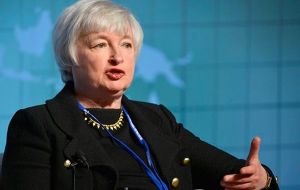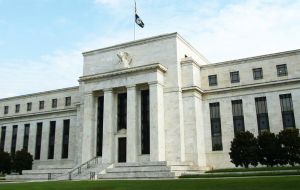MercoPress. South Atlantic News Agency
Fed leaves rates unchanged on concerns about a weak world economy
 In what amounted to a tactical retreat, the US central bank under Janet Yellen decided to delay what would have been the first rate hike in nearly a decade.
In what amounted to a tactical retreat, the US central bank under Janet Yellen decided to delay what would have been the first rate hike in nearly a decade.  As to when a rates's hike, Fed repeated it wanted to see “further improvement in the labor market,” and be “reasonably confident” that inflation will increase.
As to when a rates's hike, Fed repeated it wanted to see “further improvement in the labor market,” and be “reasonably confident” that inflation will increase. The US Federal Reserve kept interest rates unchanged on Thursday in a nod to concerns about a weak world economy, but left open the possibility of a modest policy tightening later this year. In what amounted to a tactical retreat, the US central bank said an array of global risks and other factors had convinced it to delay what would have been the first rate hike in nearly a decade.
“Recent global economic and financial developments may restrain economic activity somewhat and are likely to put further downward pressure on inflation in the near term,” the Fed said in its policy statement following the end of a two-day meeting. It added the risks to the US economy remained nearly balanced but that it was “monitoring developments abroad.”
However, the central bank maintained its bias towards a rate hike sometime this year, while lowering its long-term outlook for the economy. Fresh economic projections showed 13 of 17 Fed policymakers still foresee raising rates at least once in 2015, down from 15 at the last meeting in June. Four policymakers now believe rates should not be raised until at least 2016, compared to two who felt that way in June.
The Fed has policy meetings in October 27/28 and December 15/16.
In deciding when to hike rates, the Fed repeated that it wanted to see “some further improvement in the labor market,” and be “reasonably confident” that inflation will increase.
“When the Committee decides to begin to remove policy accommodation, it will take a balanced approach consistent with its longer-run goals of maximum employment and inflation of 2%. The Committee currently anticipates that, even after employment and inflation are near mandate-consistent levels, economic conditions may, for some time, warrant keeping the target federal funds rate below levels the Committee views as normal in the longer run”.
Taken as a whole, the latest Fed projections of slower GDP growth, low unemployment and still low inflation suggest that concerns of a so-called secular stagnation may be taking root among Fed policymakers. One policymaker even suggested a negative federal funds rate.
The median projection of the 17 policymakers showed the Fed expects the economy to grow 2.1% this year, slightly faster than previously thought. However, its forecasts for GDP growth in 2016 and 2017 were downgraded.
Policymakers also forecast inflation to creep only slowly toward the Fed's 2% target even as unemployment dips lower than previously expected. They now expect the unemployment rate to hit 4.8% next year, remaining at that level for as long as three years.
The Fed's projected path of interest rates shifted downward, with the long-run federal funds rate now seen at 3.5%, compared to 3.75% at the last policy meeting.
The vote on the policy statement was a sign of how China's economic slowdown and market slide left Fed officials unnerved about the state of the world economy. Only Richmond Fed President Jeffrey Lacker dissented.
In recent months Fed officials like board member Jerome Powell and Atlanta Fed President Dennis Lockhart had publicly endorsed a September rate hike, forming a near majority along with longstanding inflation hawks like Lacker.
In the end, however, they were left with a muddled picture marked by low US unemployment and steady economic growth, but no sign that inflation has begun to rise towards the Fed's target.




Top Comments
Disclaimer & comment rules-

Read all commentsAll they intended was a 0.25% 'increase' and all the 'leaders' of the stock market et al shit themselves.
Sep 18th, 2015 - 11:19 am 0They must really be hiding something.
The FED will NEVER willingly increase the interest rate.
Time to have government control or replace the FED with something that works.
Commenting for this story is now closed.
If you have a Facebook account, become a fan and comment on our Facebook Page!